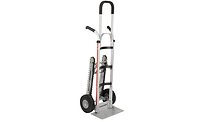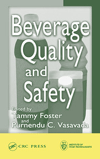Safety in and Around Trucks
David Kolman
Slip, trip and fall accidents are a significant factor in driver injuries. These accidents most often occur when a driver is involved in one of three activities: getting onto and exiting a vehicle, handling freight, and walking and climbing around a terminal or customer’s place of business.
The biggest causes for driver injuries due to slips,
trips and falls from equipment is drivers taking for granted the
three-point system while getting into or out of a vehicle cab, connecting
or disconnecting air and electrical lines, or mounting or dismounting truck
bodies and trailers. The three-point rule is a simple maneuver in which a
driver keeps three of his four limbs in contact with the vehicle at all
times — two hands and one foot or two feet and one hand, so only one
limb is in motion at any one time.
Safety professionals offer these suggestions for
drivers for greater safety when getting on and off equipment:
•
Always use the
three-point system, stay focused on the task and take your time.
•
Avoid carrying items
while entering or exiting.
•
Before stepping out or off, look for obstacles on
the ground below.
•
Do not use fuel tanks, tires or wheel ends as a
step. Such rounded surfaces can be slippery.
•
Get on and off a vehicle facing it and have a good hand-hold.
•
Never jump out of a cab, off a vehicle or from deck
plates or steps, as a driver could land off balance or on an uneven
surface.
Research has shown that a person jumping or falling
from a height of 4 feet will hit the ground with a force of between seven
and 12 times their body weight. A 200-pound driver, by way of example,
would hit the ground with a force of 1,400 to 2,400 pounds. Here are some
tips:
•
Use extra caution in adverse conditions such as snow,
ice, rain, mud and even morning dew, all of which can increase the
potential for slips and falls by making grabhandles, steps and surfaces
slippery.
•
Wear sturdy footwear with slip-resistant soles and
heels.
•
Keep such things as tools, gloves, brushes and fire
extinguishers in their proper place and out of the path of entry/exit.
•
Check the condition of grabhandles and steps during
the vehicle pre-trip safety inspection and make any necessary repairs.
Freight handling
Drivers who load or unload freight are exposed to
slip, trip and fall accidents, as well as back sprains and strains.
Preventive measures, say safety professionals, include:
•
Observe walking surfaces, look for any holes,
raised elevations, slippery or slick surfaces.
•
When working on slick or slippery surfaces, take
smaller steps and go slowly.
•
Be aware that moving from light to dark areas, or
vice versa, can cause temporary vision problems that might be enough to
cause a driver to slip or trip.
•
When using a hand truck, cart or pallet jack, avoid
pulling when possible. Pushing takes less effort, and pulling often
causes the devices to run into the shins or ankles.
•
Inside bodies and trailers, be alert for loose
material on the floor, such as broken pieces of pallets, discarded
shrinkwrap and cargo bars.
Loading docks
Loading docks and ramps are dangerous areas, as they
are frequently congested, heavy-traffic areas. Here are some tips for
staying safe around them:
•
Be conscious of uneven surfaces between the truck
bed and the dock or ramp.
•
Use the stairs and ladders that are provided to get
onto or off of a loading dock. Whenever possible, use the handrails for
additional support. Do not climb or jump onto or down from a loading
dock.
•
Ensure that dock plates are properly placed. Be
careful on those that are worn smooth or may be slippery.
•
Be cautious on and around dock plates. Falls often
happen from dock edges due to unsecured dock plates.
•
Be on the lookout for loose material on the dock
that may present trip hazards.
•
When walking along a loading dock or through a
warehouse, keep an eye out for powered material handling equipment
moving about.
•
Do not “hitch” a ride on any type of
powered material handling equipment or distract the operators.
•
Do not operate powered
material handling equipment or other industrial trucks unless licensed
to do so. This is an OSHA requirement.
•
Secure trailers and trucks to loading docks using
wheel chocks or other vehicle-restrain- ing
devices when loading and unloading.
•
Be careful walking between trailers to set and
remove vehicle-restraining devices. Other vehicles
may be pulling in and out, and there may
be hazards like potholes and debris.
•
Always check to make sure your truck is finished
being loaded/unloaded, and that vehicle-restraining devices have been
removed before pulling out.
Encourage all your drivers to report any delivery
and loading site trip, slip and fall haz ard conditions they are exposed
to. Along with a reduction in injuries and improvements to productivity and
financial performance, the benefits of a safer workplace include lower
workers’ compensation costs and medical expenses, avoiding OSHA
penalties, and reduced costs to train replacement employees and conduct
accident investigations.
David Kolman is a veteran truck communicator,
keynote speaker and long-haul trucker. Commissioned
as an Honorary Colonel on the Kentucky governor’s
staff for his work promoting traffic safety, he actively
participates in trade associations and reports news
and information about the trucking industry for
broadcasting and print media.



